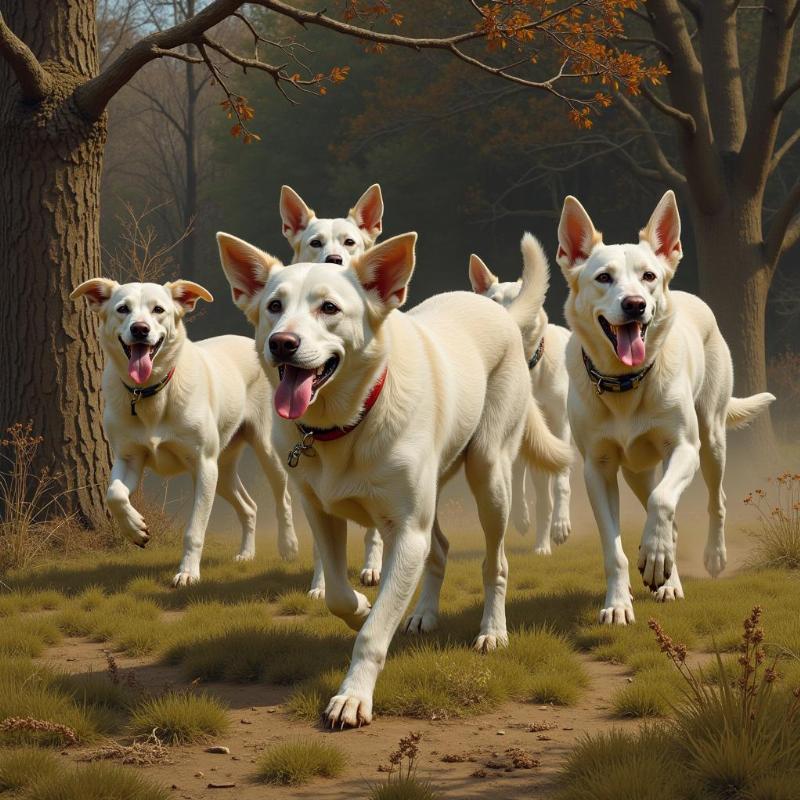The Talbot dog, a now-extinct breed, holds a fascinating place in canine history. While you won’t find a Talbot romping in your local dog park, understanding their legacy provides insights into several modern breeds. This article delves into the history, characteristics, and lasting impact of the Talbot dog.
The Mysterious Origins of the Talbot Dog
Pinpointing the Talbot’s exact origins is challenging, shrouded in the mists of time. Many believe they descended from white St. Hubert hounds brought to England by William the Conqueror after the Norman invasion of 1066. These hounds were renowned for their exceptional scenting abilities and were primarily used for hunting. The Talbot dog quickly became popular among English nobility, prized for its tracking prowess and striking white coat.
Characteristics of the Talbot Dog
Descriptions of the Talbot dog paint a picture of a powerful, pure white hound. They were large, with a deep chest, strong legs, and long, drooping ears. Their most distinctive feature was their pure white coat, which made them easily visible during hunts. Beyond their physical attributes, Talbots were known for their gentle nature, making them suitable companions as well as skilled hunters.
 Chó Talbot săn bắn
Chó Talbot săn bắn
The Talbot’s Legacy: Influence on Modern Breeds
While the Talbot dog itself is extinct, its bloodline likely contributed to the development of several modern breeds. The Beagle, Bloodhound, and Foxhound all share characteristics with the Talbot and are believed to have descended from it, or at least share common ancestors. These breeds inherited the Talbot’s keen sense of smell, hunting instincts, and even aspects of its physical appearance.
The Talbot in Heraldry and Culture
The Talbot’s prominence in medieval England extended beyond hunting grounds. Its image became a popular heraldic symbol, appearing on coats of arms and family crests. This further cemented the Talbot’s status as a symbol of nobility and prestige. Even today, the name “Talbot” continues to appear in place names and pub names throughout England, a testament to the breed’s enduring legacy.
Why Did the Talbot Dog Disappear?
The precise reasons for the Talbot’s extinction remain uncertain. Theories suggest that changes in hunting practices, combined with the rise of other hunting breeds, may have led to its decline. Another possibility is that the breed was gradually absorbed into other breeds through crossbreeding, eventually losing its distinct identity.
Conclusion
The Talbot dog, though extinct, remains a significant figure in canine history. Its legacy lives on through its influence on modern breeds, its presence in heraldry, and its lingering presence in English culture. Understanding the Talbot’s story provides valuable insight into the evolution of dog breeds and the rich tapestry of canine history.
FAQ
- Are there any Talbot dogs alive today? No, the Talbot dog is considered extinct.
- What did Talbot dogs look like? They were large, white hounds with long, drooping ears and a muscular build.
- What were Talbot dogs used for? Primarily for hunting, particularly tracking game due to their excellent sense of smell.
- What breeds are descended from the Talbot? The Beagle, Bloodhound, and Foxhound are believed to have Talbot ancestry.
- Why did the Talbot dog become extinct? The exact reasons are unknown, but theories include changes in hunting practices and crossbreeding with other breeds.
- Where does the name “Talbot” come from? The origin is uncertain, but it may derive from a Norman family name.
- Can I find images of Talbot dogs? Yes, historical illustrations and depictions in heraldry provide visual representations of the breed.
Beautdogs.us: Your Trusted Source for Dog Information
Beautdogs.us is your premier online destination for comprehensive and engaging information on dog care, breeds, and products. Whether you’re a seasoned dog owner or just starting your journey, we provide expert advice on everything from breed selection to training and nutrition. Our team of experienced veterinarians and dog enthusiasts is dedicated to helping you provide the best possible care for your furry companion. Connect with us for personalized guidance and support! Email: [email protected], Phone: +1 501-555-7529.